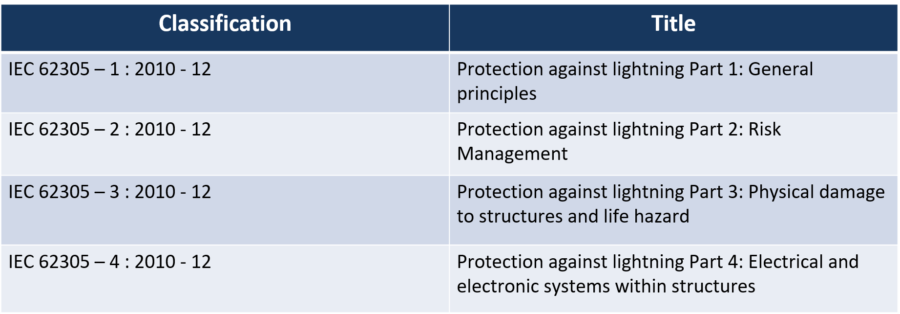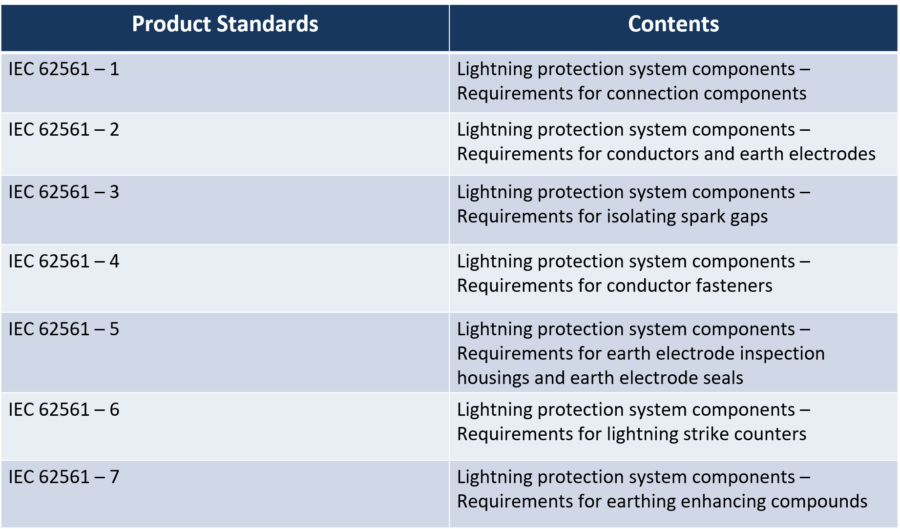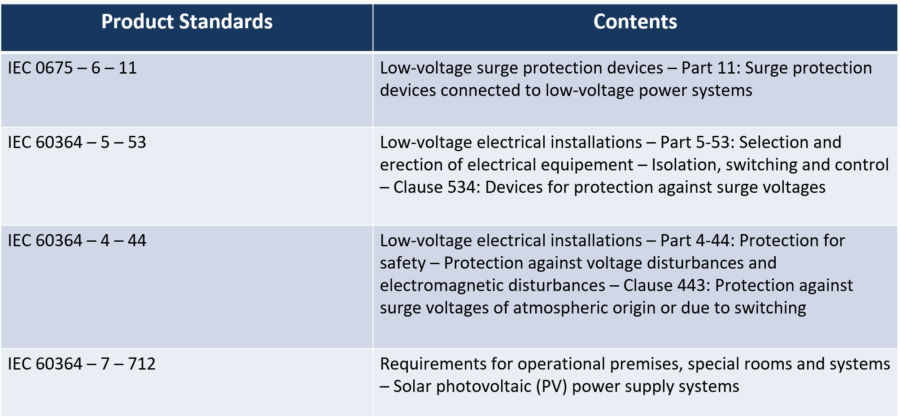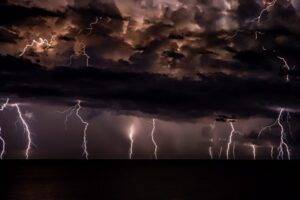In this article, we will be referring separately to design and component standards for Lightning Protection and Earthing. The Light Protection Design engineer or installer uses the design standard to design the complete lightning protection system including placement of the components. Lightning protection component manufacturers, such as us, use the component standards to ensure product compliance and quality.
IEC 62305 – Designing for Protection Against Lightning
IEC 62305 – Protection Against Lightning, is the apex level document that informs the standards for lightning protection around the world. It is a design standard that comprises of four documents that provide the lightning protection designers with the rules and regulations they require to design an LPS. The IEC 62305 standard covers the regulations required for the protection of equipment and structures from the effects of both direct and indirect lightning strikes. The diagram below which is taken directly from the IEC 62305 document, clearly shows the relationship between the 4 parts of the standard. Part 1 is a general introduction to the threat of lightning, part 2 delves into the calculation of lightning risk, part 3 describes the design of the Lightning Protection System (LPS) and Part 4 describes the design of the Surge Protection Measures (SPM).

IEC 62305, does not consider the following cases under the scope of the standard:
- Railway Systems
- Vehicles, ships, aircraft, offshore installations
- Underground high-pressure pipelines
- Pipe, power and telecommunication lines placed outside the structure

IEC 62305-1: General Principles
Part 1 of the standard is a general introduction to the entire standard in addition to the properties of lightning and the factors used to simulate the effects of lightning strikes. The basics of procedures and principles of protection that are used in the rest of the standard are also explained in IEC 62305 Part 1.
IEC 62305-2: Risk management
Part 2 of the standard is the key to the correct implementation of Part 3 and Part 4 of the standard. IEC 62305-2 is concerned with the Risk Assessment of a structure due to lightning flashes and to determine whether it requires a lightning protection system. This part of the standard provides the complete framework for Risk Assessment based on four types of losses namely ‘Loss of human life or permanent injuries’, ‘Loss of service to the public’, ‘Loss of cultural heritage’ and ‘Economic loss’. Protection measures can be determined based on this Risk Assessment and a residual risk is established. This residual risk is reduced using protection measures until it is below the tolerable risk. We can use this method to determine the class of LPS based which are in compliance with IEC 62305-3 and 62305-4. As summarised in IEC 62305-2, “Once an upper tolerable limit for the risk has been selected, this procedure allows the selection of appropriate protection measures to be adopted to reduce the risk to or below the tolerable limit.”
Axis has used the guidelines of IEC 62305 Part 2 to design a Risk Assessment Software that allows you to easily calculate and assess the risks to determine the Class of LPS for your structure. This software uses parameters unique to your structure to help you determine the best and most efficient protection system. The risk assessment software is part of a bundle that always allows customers to also easily calculate earth rod length requirements, separation distance for lightning arrestors, Surge Protection Device (SPD) selection and more! Please contact us for more information on our software suite.
IEC 62305-3: Physical damage to structures and life hazard
Part 3 deals with the protection of people and structures from physical damage and injury due to touch and step voltages caused due to direct lightning strikes. The standard states that the “main and most effective measure of protection of structures from physical damage is considered to be the lightning protection system (LPS)” which consists of external lightning protection (air termination system, down conductor system and earth termination system) and internal lightning protection (equipotential bonding and separation distance). IEC 62305-3 provides the guidelines to help “LPS designers and installers, architects and builders” to correctly design, install and maintain the external and internal lightning protection systems to protect people from touch and step voltages.
IEC 62305-4: Electrical and electronic systems within structures
Part 4 was introduced due to the ever-increasing cost of failures of electrical and electronic systems in our digital world. IEC 62305-4 provides the details for the design, installation, inspection, maintenance and testing of Surge Protection Measures (SPM) to protect electrical and electronic systems from the effects of Lightning Electromagnetic Impulses (LEMP).
Part 4 also introduces the idea of Lightning Protection Zones (LPZ). The central idea is to limit current and voltage surges, induced by lightning or otherwise, from damaging a structure or its contents (people or equipment) by dividing the structure into a risk zones. These zones are nested within each other, with the most sensitive zones being the innermost. A risk assessment according to IEC 62305-2 is performed for each zone to select the most appropriate protection at the optimum cost for that zone. By using standard appropriate lightning protection systems, such as lightning arrestors and SPD’s, the effects of lightning hitting the outer zone, directly or indirectly, are meant to be reduced before they can affect people or sensitive equipment in the inner zones.
Axis can help you with the entire process from Step 1 of Risk Assessment to Lightning Protection System Design and all the way through the supply of internationally approved products. Our engineers will be on the field with you to make sure that they provide the most precise protection for your structure! Contact us for more information.
IEC 62561 – Lightning Protection System Components (LPSC)
The IEC 62561 series describes the requirements and tests for the various lightning protection system components (LPSC). It summarises the test requirements for the components of a lightning protection system (LPS) that is designed and implemented as per IEC 62305. The various components of the LPS include:
- Connection components such as lightning conductor clamps, bonding & earthing clamps, bridging components, pipe clamps, equipotential bonding bars
- Conductors and Earth Electrodes (link to the Earth Electrodes blog)
- Isolating Spark Gaps
- Conductor Fasteners
- Earth Pits
- Lightning Strike Counters
- Earth Enhancing Compounds
You should only procure products certified according to international or national standards for your lightning protection requirements to ensure that the products perform according to the requirements of the design of the lightning protection system. Axis has supplied the entire range of products for Lightning Protection for over 25 years to hundreds of projects across the world. View our catalogue for our Lightning Protection Products

Other IEC Standards Used for Lightning Protection


Conclusion
The IEC 62305 and IEC 62561 standards form the foundation of modern lightning protection system (LPS) design and testing worldwide. While IEC 62305 focuses on the overall framework—covering risk management, structural protection, and surge protection measures—IEC 62561 ensures that each system component meets rigorous performance and safety requirements. Together, they guarantee that lightning protection systems are both reliable and compliant with international best practices.
By adhering to these standards, engineers and facility owners can design, install, and maintain systems that effectively safeguard structures, equipment, and human life from lightning hazards. Axis supports clients through every stage—from risk assessment and design to testing and product supply—ensuring complete compliance with IEC standards for long-term safety and reliability.
This article is part of our series of articles on Lightning Protection, Surge Protection & Earthing, you can read more with the following links:
Introduction to the basics of Lightning Protection and Earthing and the Standards (IEC 62305 and UL 467)
Surge Protection Devices (SPD)
Lightning Protection Zones and their Application to SPD Selection
How does a Lightning Arrester work?
For more information, please contact us at axis-india.com/contact-us/









